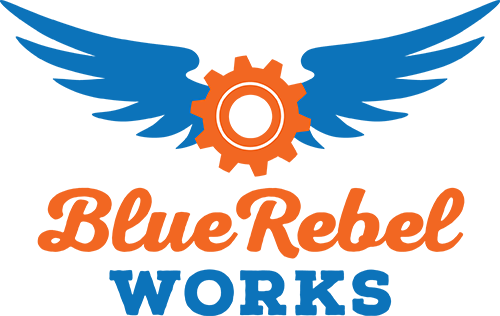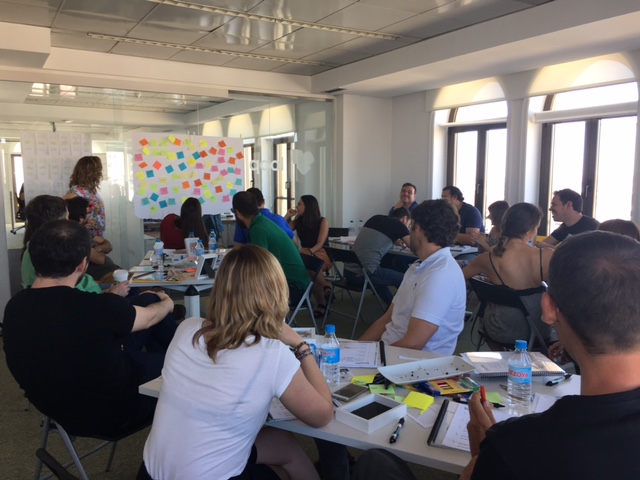Our leadership development programs have seen amazing results – double digit increases in ratings of manager trust, communication, one-to-one meetings, feedback and more. We know we’re doing something right… but what is it? Part of it is our format – we don’t do long boring training sessions where 30 days later, you only remember 10% of what you learned. We mix half-day workshops with small group peer coaching sessions, individual assessments and personal coaching, and accountability check ins. Plus, we bring everything together with our beautifully designed Leadership Journey journal.
But another big part of the impact is how we facilitate. So, as we look to build our team, the next facilitator to join us has to have that special sauce that makes our participants want to come back, and our clients extremely happy.
It’s hard to recognize in myself what I do when I’m facilitating, so I sat in on one of our workshops that was being facilitated by one of our contract facilitation partners, Kim. I watched the way Kim interacted, how closely she followed our facilitator guide, and what other little things she did to ensure the best learning was taking place. I reflected on which of these were Kim’s unique special sauces and which I shared with her. Everyone will have their own unique style – and that’s awesome – but there are likely a few things that are just non-negotiable, that we all need to do really well.
Here’s my list of the non-negotiable facilitator skills.
1) Flex.
Flex your style to the group and throughout the workshop to the variety within the group. We use Thomas International’s PPA profile to generate super-accurate DISC profiles for ourselves and our clients. While we teach others how to use their style optimally and when to flex and use other behavioural styles, we practice this ourselves. In the workshop I was observing, Kim, a low C (Compliance behaviour) naturally, got into details at times to ensure the group, made up of 80% high Cs, got the most out of the information.
2) Eavesdrop.
When small group discussions are happening, eavesdrop and watch for themes and a-ha moments that you can ask people to share. I like to give them a heads up, celebrating their discussions and preparing them to share as I listen.
3) Probe.
Ask probing, open questions to force participants to get clear about what they think. Then recognize them for sharing. A couple of our favourite probing questions: “Tell me more” and “What does that look like in action?”
4) Ask, don’t tell.
When there’s an opportunity to provide some knowledge, asking questions will often have the group develop the knowledge without being told – always opt for this instead of an info download. We’ve all been to workshops where we felt like we were being lectured. We always look for ways to have people work through the details together rather than giving them the answers.
5) Apply it.
This is so key. I’ve been to some really engaging and interactive workshops where we had a tonne of fun, but little to use back at work. We use lots of gamified activities and experiential exercises in our workshops, and work to get the group to see how they can apply the learning to their every day work. “Consider the application of this on the job,” and “In what ways does this happen at work?” are two of the questions we find ourelves asking.
6) Wander but come back.
Although we do our best to structure our workshops and include clear facilitator’s notes, you’re bound to get off track, either by your own mistake or due to conversations that happen in the group. A great facilitator is able to find their way back to ensure the key learning is achieved. They think on their feet and adapt activities to the time allotted, discussions questions to how the group is thinking and lead the learners to the right point.
7) Use real life examples.
I find the best facilitators have lots of leadership experience to share. There’s often a story from your personal history to share, briefly because it’s not all about you. These real examples add credibility and richness. Both Kim and I have operational and HR experience. We’ve led teams, programs and strategy for different organizations. If there’s a mistake to be made, we’ve done it. We’ve learned lots and have changed throughout our careers, and sharing brief stories and experiences helps to bring the learning home for our clients.
8) Be there.
If I’m being totally honest, Kim is better at this than I am. I really work to calm my mind and, as my coaching trainer would say, “dance in the moment,” but I know I often move too quickly for people. When you’re facilitating, it’s important to make sure people know that what they have to say is important, relevant and worth sharing. Genuine eye contact, a pause, and recognition of what they shared is key. Be careful not to jump to the next person too quickly without being there fully for the first.
9) Make it uncomfortable.
We’ve all seen the drawing of the comfort zone and where learning and growth really happen, outside it. As a facilitator, it’s your job to push people beyond what they are comfortable with. Pushing people to share vulnerably and openly is one of the most important things we do. Sometimes that means some discomfort for you and the group – challenging answers to force deeper reflection and truth. One of the great things about our programs is that they take place over time, and we find by building trust over time, we can push and challenge and keep a strong relationship with our client teams. They know that we only ever have their best interest at heart.
10) Read the room.
This is so important, and probably one of the first things facilitators learn. Watch people’s body language. Are they leaning forward, listening and engaged, or is attention waning? Are they fully understanding the question you asked or the activity they are about to do? You can tell by the expressions on their faces. Do they need a break? Is there an elephant in the room that needs to be discussed before they’re open to learning? Constantly watch reactions or the lack of reaction of your participants, and be ready to change things up if you need to re-energize or re-engage them with an activity, a break or a discussion.
11) Have FUN!
This should probably be number 1. I think a great facilitator is vulnerable enough to laugh at themselves. There’s a genuine, natural humour in the things we do. We bring games into our learning in a variety of formats, but Facilitation fun goes beyond that. It’s about unscripted humour and an ease with fun and laughter.
What else makes a great learning and training facilitator? And if you happen to be local to the GTA / West GTA, and are interested in working with Blue Rebel Works, contact me!


Recent Comments